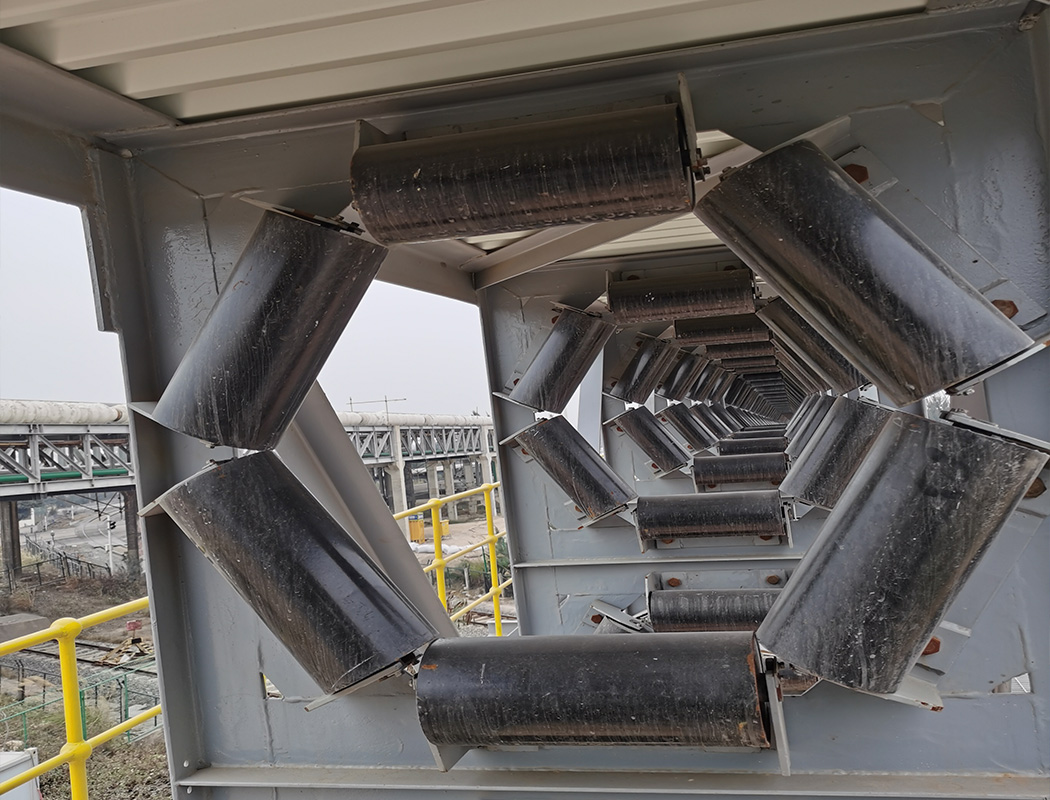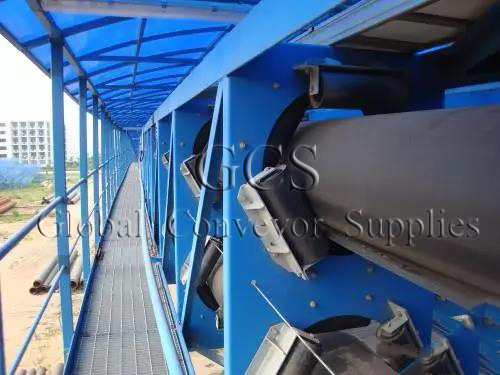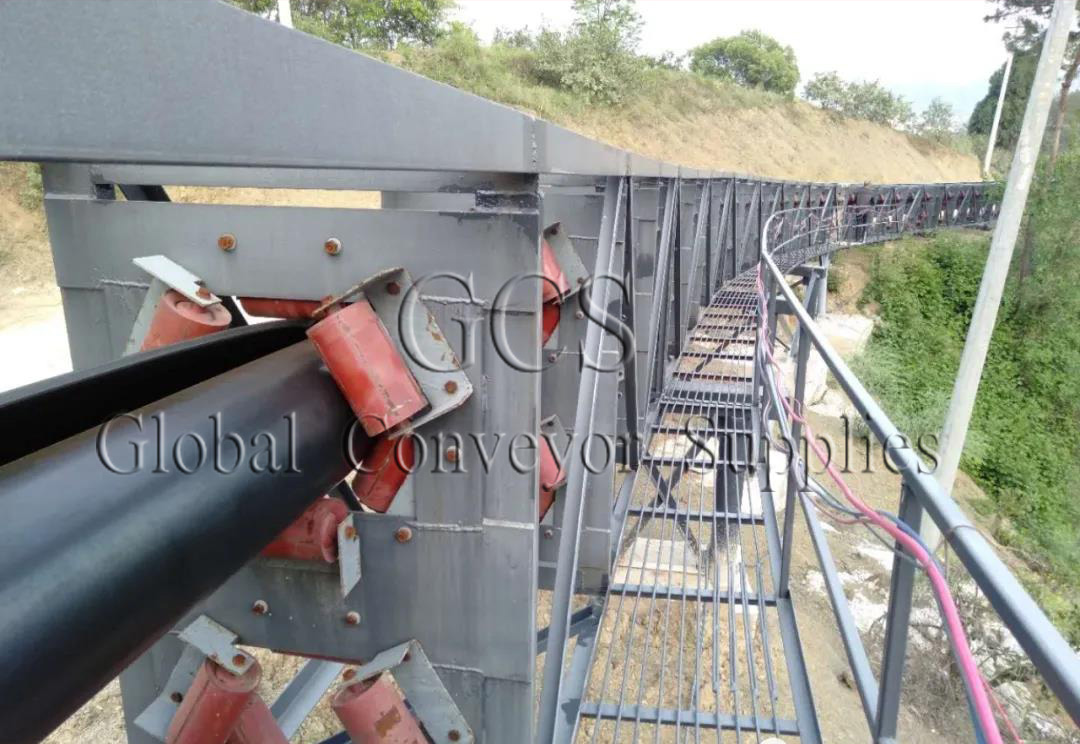Pipe belt conveyor and application scenarios
The pipe conveyor includes a driving sprocket, corner sprocket, rotary chain, material-carrying chain piece, a circulating conveying pipe, and inlet and outlet. The slewing chain is sleeved on the driving sprocket and corner sprocket, the material-carrying chain piece is inserted vertically on the slewing chain, and the circulating conveying pipe is sleeved outside the slewing chain. All of them except the inlet and outlet constitute a closed powder conveying circuit.
The pipe conveyor has a wide range of applications. It can transport materials vertically, horizontally, and obliquely in all directions. And the lifting height is high, the conveying length is long, the energy consumption is low, and the space is small.
Applications:
Fine chemicals: pigments, dyes, coatings, carbon black, titanium dioxide, iron oxide, ceramic powder, heavy calcium, light calcium, bentonite, molecular sieve, kaolin, silica gel powder, activated carbon, etc.
Pesticide ore: urea, ammonium chloride, ammonium bicarbonate, soda powder, solid pesticide, tungsten powder, pesticide adjuvant, copper concentrate powder, coal powder, phosphate rock powder, alumina powder, etc.
Building materials: cement, clay, yellow sand, quartz sand, clay powder, silica, limestone powder, dolomite powder, sawdust powder, glass fiber, silica, talcum powder, etc. Food industry: flour, starch, cereals, milk powder, food additives, etc.
1
The pipe conveyor has many superior features, of which environmental protection is the most important one. Under the increasingly stringent national environmental protection requirements, most of the raw material transportation requires the use of closed conveying equipment, and pipe conveyor is gradually becoming a preferred option.
The environmental protection characteristics of China's pipe conveyor mainly refer to the control of dust not to overflow, which ensures that the central pipe forming part can seal the material during transportation.
The head and tail expansion sections follow the traditional ordinary belt conveyor method, which is controlled by the head funnel and chute, and the tail receiving part is closed by the closed guide groove, and the dust collector is connected to the guide groove part with strict requirements.
2
Let’s take a look at foreign designs first, how to achieve fully airtight environmental protection? This configuration is rarely seen in China
3
We will have questions, the pipe conveyor has already wrapped the material into a pipe, why does it need to be fully enclosed? Is the pipe conveyor not environmentally friendly?
First of all, it needs to be clarified that this environmental protection is relative, not absolute.
From the structure itself, the tape is lapped to form a tube, and there must be gaps at the lap joint. Considering the influence of the lateral stiffness of the tape, the tape between the two groups of hexagonal idlers will still expand, which cannot be completely closed in theory.
For dry materials with small granularity, such as cement clinker, fly ash, etc., when the belt passes between the roller groups, the material will vibrate to a certain extent, and the dusty material will overflow. In this case, it is necessary to consider using a Fully enclosed structure. For materials that are not easy to dust, it is not necessary to consider the entire line of closure.
The picture below is the scene photo of the cement clinker transportation. The aggregate at the head and tail of the pipe belt machine is very serious, and there are also some aggregates in the middle part of the pipe. But it can be concluded that this situation is not caused by the twisting of the tape, but the natural deposition and adhesion of dust on the surface of the closed color steel plate and steel structure.
4
Compared with the traditional belt conveyor corridor that is completely closed, the advantages of the entire line of the pipe belt conveyor are: firstly, it isolates people and materials, and the maintenance personnel can not directly contact the dust, to achieve real environmental protection; secondly, the closed area is small, All materials are also less and the cost is low.
The air quality inside the corridor where the iron powder is transported in the steel mill is extremely poor. If the lime powder is transported, people cannot enter at all. At least one must wear a mask. I have tried to enter the site without any protective measures. People suffocate.
5
For dust materials, the basic principle of true environmental protection is to ensure that materials do not leak, and at the same time to ensure that the working environment of workers is clean.
Structural Design Suggestions:
1. The truss structure is adopted for the head and tail expansion sections, which is convenient for the laying of closed color panels, and the overall aesthetics are also good;
2. The tail drum is mounted on the tail truss, and the drum shield adopts a closed steel plate structure;
3. The side closing plate is made into a structure that is easy to disassemble, and it is easy to remove and install during maintenance;
4. Considering the convenience of maintenance and inspection, the side closing plate can add an observation window, or use transparent material closing plate;
5. If the truss is fully enclosed without opening windows, some automatic detection equipment can be added to facilitate positioning and maintenance.
belt conveyor idler manufacturers
Successful Cases
Post time: Jan-17-2022






